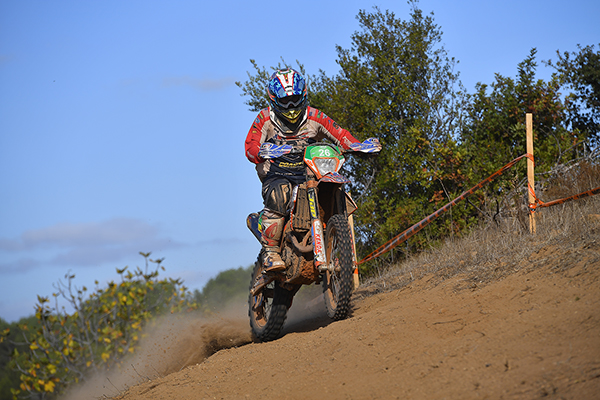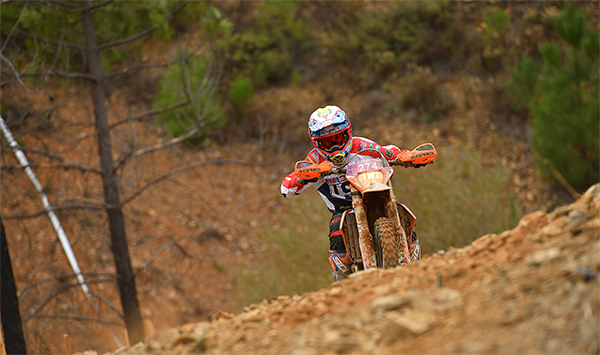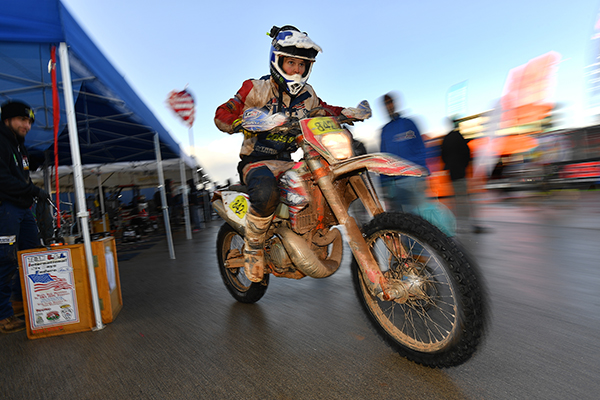AMERICAN MOTORCYCLIST January 2020
Almost perfect in Portugal
U.S. World Trophy, Women’s World Trophy teams take top honors at ISDE
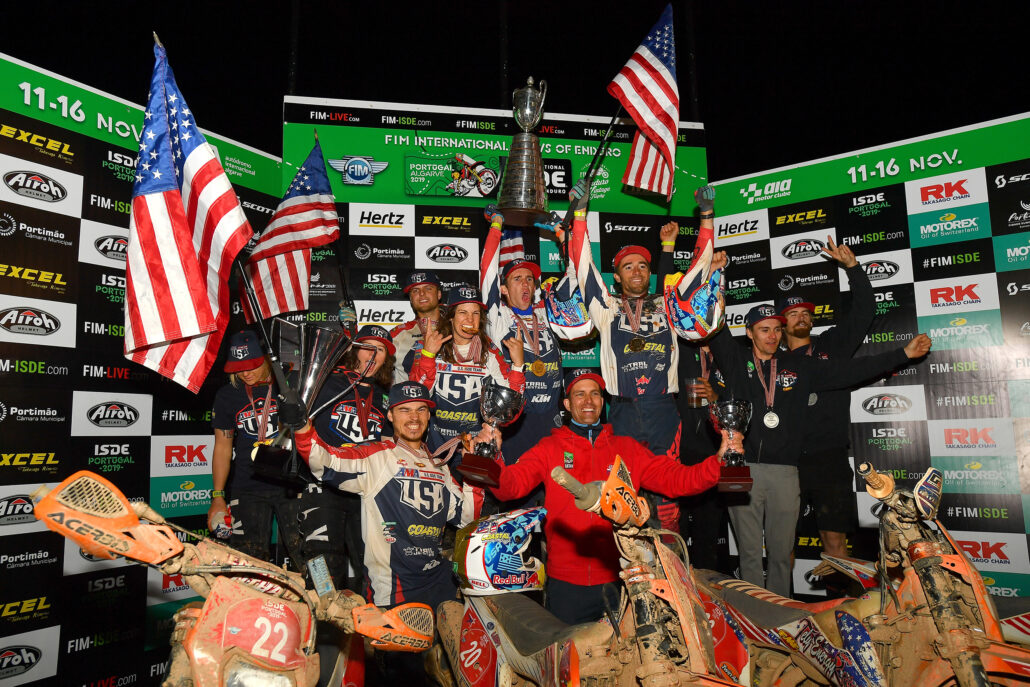
By Mark Kariya
In 2018 at the 93rd FIM International Six Days Enduro in Chile, the U.S. ISDE team enjoyed unprecedented success, nabbing second place in all three elite categories: FIM World Trophy, Junior World Trophy and Women’s World Trophy.
But that wasn’t good enough. Nobody remembers second place.
Everyone involved in this year’s effort believed it was possible to duplicate the squad’s 2016 success in Spain, when the U.S. World Trophy Team won enduro’s longest-running international competition.
The team approached the 94th ISDE in Portimao, Portugal, with renewed determination and sense of purpose. Many arrived earlier than usual to walk each special test multiple times—logging 75 miles or more in just over a week—and give themselves a bit of time to recover.
The effort paid off. The U.S. World Trophy Team and Women’s World Trophy Team took first place in Portugal. And the U.S. Junior World Trophy Team finished second.
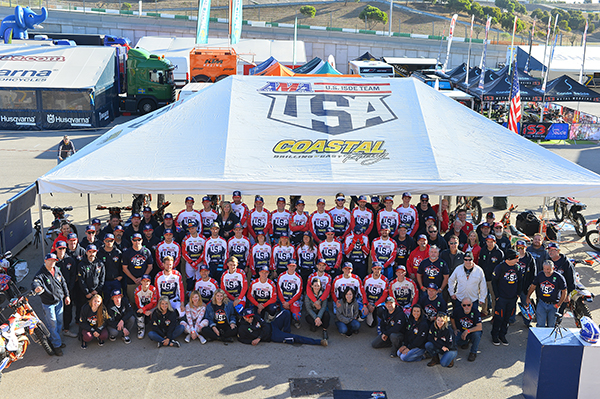
There are 31 riders, plus mechanics and just a few of the less camera-shy support crew in this shot. Every person played a crucial role over the week.
The 2019 team was full of proven performers, each with several ISDEs on their résumés. The World Trophy Team included Steward Baylor, Taylor Robert, Kailub Russell and Ryan Sipes. The three competitors on the Junior World Trophy Team (younger than 24 years old) were Grant Baylor, Ben Kelley and Josh Toth. Tarah Gieger, Brandy Richards and Becca Sheets made up the Women’s World Trophy Team.
Sipes, who was America’s first individual overall winner in 2015, said on Day Four of the 2019 contest, “I missed out on the 2016 championship team, the [overall] winner [in Spain], so I want to be on one. That’s the goal, to stay solid and have some good test times tomorrow and keep her up top.”
His comment came the day after the U.S. World Trophy team supplanted Australia at the top of the standings. And the team added to the lead from there, until the final day of competition, when things were well in hand. It then became more important to stay in front as a team than take risks individually.
Early in the week, Australia enjoyed the lead, as it sought to defend its 2018 title from Chile. The team’s early lead was primarily due to the phenomenal test times racked up by Daniel “Chucky” Sanders, times that no one else could match—at least on a consistent basis.
As Baylor wryly observed, “I don’t think any of us are riding as good as we should be or as good as we could be. That’s tough for all of us and tough to keep your head in it, and the general attitude has obviously changed since the morning before the race started. It doesn’t help that Sanders is making us look like a bunch of monkeys.”
- As is often the case in other countries, the Portuguese special tests featured plenty of off-cambers, though Grant Baylor coped well enough to keep the throttle pinned en route to the U.S. Junior World Trophy team finishing second.
- Portugal was Ricky Russell’s first try at Six Days and he shadowed teammate Dante Oliveira almost every day. On Day Three, he was the second-fastest Club rider, besting both eventual individual winner Antoine Meo of France and Oliveira.
- Brandy Richards started the week quickly, leading all women until the rains came on Day Three and she admittedly began to struggle. While she fired back on drier Days Five and Six, she’d relinquished too much time and had to settle for second woman overall.
The thing about Six Days, though, is it’s a team sport. Realizing this, the Americans decided to forget about trying to beat Sanders. Instead, the focus turned to packing the top 10 overall each day with Americans, and that’s something they were able to do consistently.
Robert led the E2 class from the outset and put himself third individual overall behind E3 leader Sanders and E1 king Josep Garcia of Spain.
Being in the same class as Sanders gave Baylor a large chasm to bridge, something made more difficult since he was on a different bike (a 500) than the 450 he normally races. The switch was made to give the team at least one rider in each class. Day Four was his best, as he finished fifth overall, third in E3.
The team’s E1 entrant, Spies, started the week third overall but didn’t maintain the consistency he’d hoped for, floating into and occasionally out of the top 10.
“I know I can ride a little bit better, but I just wanted this team to win—that’s my main goal,” he insisted.
Sipes ended up riding well enough to contribute to the team’s top three scores most days and claimed second in E2, sixth overall individual at the end of the week, as the team celebrated only its second World Trophy win.
Robert said, “I wasn’t as nervous going into this [Six Days], but it honestly felt a little bit better [than that first win in Spain], and I don’t know if it’s just because it’s fresh.
“But just to back it up [means a lot], and the team just rode so good this year! In Spain, we got a little lucky. I know some of the other teams had some issues. But here, none of the other teams had issues—we just straight up rode the best. All four of us were really consistent, especially the three scores that counted every day, we were really tight. I think we got three guys in the top seven [overall] every day, which is unheard of for us, so that felt really good.”
U.S. Women’s World Trophy Team
While the U.S. Women’s World Trophy Team won the class’s debut in Chile in 2007—with Nicole Bradford, Lacy Jones Laurent and Amanda Mastin—France and then Australia have owned it since then, with five and six consecutive victories, respectively.
But this year’s American trio ended that two-headed dynasty. Each American woman contributed one of the two daily scores that counted and all three were within the top eight women overall each day.
Coming off a standout year at home, Richards placed herself at the top of the standings the first two days, ahead of Germany’s Maria Franke and GNCC champ Tayla Jones of Australia.
When the weather turned sour on Day Three, Franke took over the top spot, putting enough time on Richards that the American topping the final two days wasn’t enough to dethrone the German.
“I really struggled in the first and the fourth tests [on Day Four],” Richards admitted. “It was so muddy I was mostly just trying to stay off the ground, but even with trying to do that, it set me back a little bit.”
The American women took the lead on the second day and stretched it from there, eventually winning by a sizable 8 minutes, 51.21.
“I knew it might take us a couple years to get used to the whole [ISDE] racing format, but I knew we could do it,” Richards declared.
Junior World Trophy Team
For the U.S. Junior World Trophy Team, the week was filled with flashes of speed, though they found themselves unable to stay with the trio from Australia. Two Aussies occupied the top 10 overall practically daily, giving every other country a huge hurdle to overcome.
Grant Baylor was the lone American Junior to break into the top 10, which he did once, and the team finished second to Australia by a sizable 9 minutes, 13.94 seconds.
Baylor admitted, “I can’t complain with that [result]. The team gave it their all and we pushed 100 percent. We were just outdone by the Aussies.”
He added, “This year was my best personal result [sixth in E2 and 14th overall]. On top of that, I had my best [final] moto result on Day Six here [fourth place]. I was happy with that on Day Six and to finish out the Six Days strong.”
Validation
Going 1-2-1 validated the three-year plan that team manager Antti Kallonen implemented when he took over the program.
“We go back seven or eight years, and we were just starting this program,” he said. “I got involved in 2012, and we were far away [from being regular contenders]. Occasionally we got top three.
“But once the program is going, I set a three-year plan for the Trophy [team to win]. It took a little longer. With the Juniors, we won it once, in ’14 [in Argentina], so within two years. We haven’t really won it since then, but we’ve been finishing pretty much second every year, so it’s not lack of trying or lack of talent.
“I started in ’17 managing the women and again, like in any racing, once you start, I always set a three-year plan,” Kallonen said. “You can never succeed in the first year with something. I need to learn what the women need and what we need to do.
“This is the third year, so if it actually happens now,” he said at the end of Day Five, “the plan has come to perfection.”
Club teams
American success wasn’t limited to the three elite categories.
In the Club team race for three-man squads, 124 teams signed up, but XC Gear—Dante Oliveira, Ricky Russell and Austin Walton—moved to the front immediately.
Oliveira, in particular, established himself as a future star, as he chased down leading Club rider Antoine Meo of France, a former enduro world champ and multi-time member of that country’s dominating World Trophy team.
At 35, Meo may be past his prime, but no one was able to approach his times—except Oliveira, with Russell right behind.
On Day Four, Oliveria finally squeaked past Meo for the top spot of the day, though by a minuscule 0.94 seconds.
But the young rider from northern California repeated that on each of the last two days, each time adding to the margin. Meo had established enough of a lead during the first three days to finish atop the individual Club rider standings by 38.46 seconds. Russell finished third, about two and a half minutes back, with Walton in eighth.
The other six U.S. Club teams fared well in some cases, and fell heartbreakingly short in others.
Gas Gas USA’s J.T. Baker, Tyler Vore and Trent Whisenant finished eighth, with Baker the most consistent throughout the week to earn 12th overall. Vore had to be proud of winning the C3 final moto in that class’s fastest time.
Mojo Motorsports—Anson Maloney, Josh Knight and Tanner Whipple—finished the week 12th, with Knight the best finisher at 32nd Club rider overall, 18th in C2.
The Elizabeth Scott Community team of all senior riders—Jayson Densley, Paul Krause and Brian Storrie—enjoyed a good Day Six, climbing one final step to finish 31st.
Eric Cleveland Memorial’s Kevin DeJongh, Nic Garvin and Austin Serpa finished the week spectacularly, with both DeJongh and Garvin winning their final C2 motos.
However, since DeJongh had a DNF on Day Five due to an electrical problem, the three hours added to the team’s time limited them to 47th.
The Missouri Mudders—James King and Nathan Rector, with Anthony Krivi a DNF on Day Three—ended the week 79th.
AMA District 37 lost Blayne Thompson and Jacob Argubright early on, a huge blow, since both first-timers showed competitive speed from the beginning.
That left veteran Nate Ferderer as the team’s sole survivor. He soldiered on to 30th overall Club rider, seventh in C1.
ISDE not just about star riders
Three questions with club team rider Tanner Whipple
You don’t have to be Kailub Russell or Ryan Sipes to compete at an event as prestigious as the FIM International Six Days Enduro.
The U.S. ISDE Club teams are made up of everyday riders who race their way onto a team.
One of those club riders is Tanner Whipple.
The 18-year-old off-road racer from Colona, Ill., got an unexpected chance to compete at the 2019 ISDE as a replacement rider.
American Motorcyclist interviewed Whipple shortly after the 2019 ISDE took place.
American Motorcyclist: What was your impression of the ISDE?
Tanner Whipple: The experience was amazing in every aspect. I found out I was going two weeks before the event, as I had initially missed qualifying for the team by one spot. I hadn’t done much work on my bike all year and practiced changing tires each night to get ready for the event.
AM: Tell us about your racing experience leading up to the ISDE.
TW: I mostly raced hare scrambles. My dad owns a 10-round hare scramble series. I also raced a little bit of motocross. And my parents both worked for the old AMA Arenacross Series, so I got to race that series.
In the past three years, I’ve started competing in more enduros, which really helped me improve my first-lap speed in hare scrambles. I’ve also been racing in the AMA Sprint Enduro Series, which is the most like the ISDE format.
AM: What are your racing plans for 2020?
TW: I’m planning on racing AMA District 17 hare scrambles and enduros. I’ll race some AMA District 16 hare scrambles, too, and want to be back on the U.S. ISDE team. I want to be like [AMA Hall of Famer] Jeff Fredette, who competed in the ISDE like 30 times.

